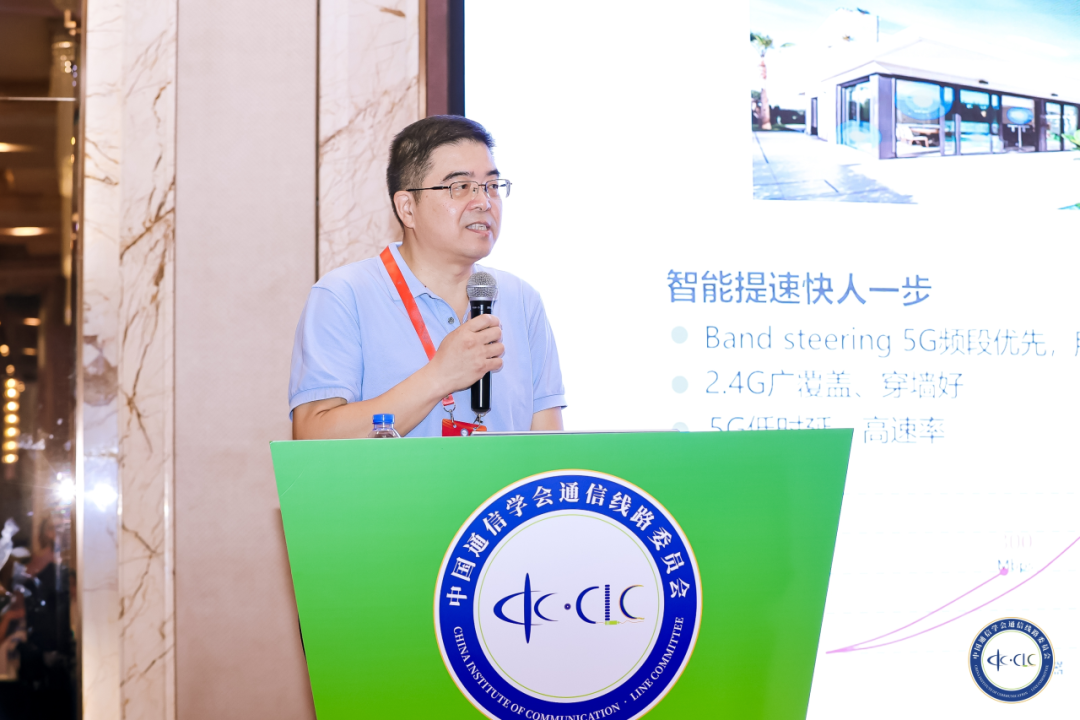Recently, the 42nd Annual Academic Conference on Communication Circuits of China Institute of Communication, themed "Communication Line in the Context of Dual Carbon and Circular Economy," was held in Shenzhen, China. Liu Cheng, a senior technical expert from FiberHome Telecommunication Technologies, was invited to deliver a keynote speech on "Selection and Research Progress of Optical Cables for FTTR Wiring." Over 200 experts and scholars from communication service providers, design institutes, communication cable manufacturers, and cable material producers attended, collectively exploring the application and development of fiber optic cables in FTTR (Fiber to the Room) wiring.

Pic.1 Mr.Liu Chen was in the the 42nd Annual Academic Conference of CIC
Liu Cheng pointed out that since the release of the F5G standard by ETSI in 2020, the global development of gigabit industries has entered a fast lane. As the foundational infrastructure and support base for gigabit networks, fiber optic cables play a crucial role. FTTR technology utilizes optical fibers to replace traditional network cables, offering characteristics such as low latency, high bandwidth, no attenuation, and strong wall-penetration capabilities. This breakthrough overcomes the speed bottleneck of traditional network cables, extending stable gigabit Wi-Fi networks to every corner of each room. When deploying fiber optic networks within rooms, it is essential to consider factors such as the convenience, efficiency, accuracy of installation, and the aesthetics of interior decoration. Therefore, suitable installation schemes and cable products need to be adopted for different FTTR wiring scenarios.
Concealed Duct Installation:
Concealed duct installation involves utilizing existing indoor pipelines and pulling optical cables into various rooms through the traction of old lines. Its advantages in aesthetics, safety, and easy-construction make it the mainstream choice for FTTR wiring. Commonly the cables used for concealed duct installation include outdoor cables, bow-type drop cables, round drop cables, indoor cables, and hybrid optical-electrical cables. Among these, butterfly-type drop cables, with advantages like small size and low cost, are the preferred choice.
Currently, the two common problems with bow-type cables during construction include a high surface friction coefficient, which making it challenging and time-consuming to install in narrow ducts with small bending radii and numerous corners. Additionally, the flat structure of butterfly cables may lead to twisting problems, potentially causing increased the risks of fiber attenuation or breakage.
To address the difficulties in bow-type cable installation, FiberHome has developed low-friction bow-type cables, reducing the surface friction by 75%. With no need for old-line traction during construction, these cables can be directly pushed into narrow duct units, significantly lowering the installation difficulty. Furthermore, FiberHome has also pioneered the development of round drop cables to solve twisting issues in specific scenarios, adapting to various complex installation environments.
Surface Installation:
Surface installation is typically used in scenarios where no indoor reserved pipelines are available, or it is impossible to thread cables through existing pipelines. Commonly used cables, including bow-type drop cables and round drop cables, can be employed. Invisible cables can be laid along baseboard gaps, maintaining the aesthetic appearance of interior decoration and are more suitable for surface installation. However, the transparent sheathing material used in current invisible cables may experience aging and yellowing over prolonged exposure to light and heat, affecting the invisible aesthetic effect.
FiberHome has developed a novel invisible cable that utilizes a unique anti-yellowing sheathing material. Long-term simulated aging experiments have shown that the material's anti-color change lifespan is more than three times that of ordinary materials, effectively addressing the durability and aesthetic issues of invisible cables.
FiberHome not only focuses on the research and development of FTTR fiber optic cable products but also actively participates in industry standard formulation, promoting the extension of optical fibers to end-users. Over the years, the company has drafted several crucial industry standards, including YD/T1770 "Indoor-Outdoor Optical Cables for Access Networks," YD/T 1997.1 "Drop Optical Cables for Communication Part 1: Bow-type Optical Fiber Cable," YD/T 1997.2 "Drop Optical Cables for Communication Part 2: Round-type Optical Fiber Cable," and YD/T 1258.7 " The Series of Indoor Optical Fiber Cable Part 7: Invisible Optical Fiber Cable." These standards provide unified nomenclature and stipulate corresponding product performance requirements for FTTR optical cables, standardizing and guiding their design, production, and testing, further advancing the pace of digital home construction.
Liu Cheng concluded that FTTR technology, utilizing optical fibers as the network transmission medium, can meet the high-quality network demands of today's digitized and intelligent society. In the future, fiber optic networks are expected to become the mainstream in societal development. With the continuous development of new technologies such as 5G and the Internet of Things (IoT), fiber optic networks will integrate with these innovations, enabling broader applications and promotion, thus becoming a crucial force of driving the development of the information society. FiberHome will continue to collaborate with service providers, fortifying the FTTR full-fiber foundation, deeply exploring the value of digital connectivity, creating ubiquitous optical connections, and injecting new momentum into improving the well-being of society and fostering high-quality development in the digital.
|